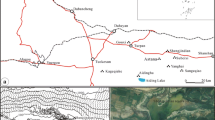Abstract
Preserved rhizomes ofCanna edulis from 5 archaeological sites in the Casma Valley of Peru are illustrated and described. These were identified by their extant surface features and by their starch grains, which are different from those of any other known flowering plant species. Based on radiocarbon assays, these specimens range in date from 2250–295 B.C. Materials used for comparative purposes in this study included a collection of edible canna from the Peruvian archaeological site of Pachacamac and a modern-day specimen. A theory on the place of origin and time of domestication of this species is given in the conclusions of this paper.
Similar content being viewed by others
Literature Cited
Bender, B. 1975. Fanning in Prehistory. John Baker, London.
Brautlecht, C. A. 1953. Starch: Its Sources, Production and Uses. Reinhold, New York.
Cardenas, M. 1969. Manual de Plantas Economicas de Bolivia. Icthus Press, Cochabamba, Bolivia.
Cohen, M. N. 1978. Archaeological plant remains from the central coast of Peru. Nawpa Pacha 16: 23–50.
Engel, F. 1970. Exploration of the Chilca Canyon, Peru. Curr. Anthropol. 11: 55–58.
Espada, D. M. J. de la. 1965. Relaciones geograficas de Indias Peru.In Biblioteca de Autores Espanoles. Vol. III. Ediciones Atlas, Real Academia Espanola, Madrid.
Gade, D. W. 1966. Achira, the edible canna, its cultivation and use in the Peruvian Andes. Econ. Bot. 20: 407–415.
Grieder, T. 1975. A dated sequence of building and pottery at Las Haldas. Nawpa Pacha 13: 99–112.
Herrera, F. L. 1934. Botanica etnologica: Filologia Quechua III [1]. Rev. Mus. Nac. 3: 37–62.
—. 1942a. Etnobotanica: Plantas endemicas domesticadas por los antiguos peruanos. Rev. Mus. Nac. 11:25–30.
—. 1942b. Etnobotanica: Plantas tropicales cultivades por los antiguos peruanos. Rev. Mus. Nac. 11: 179–195.
Kränzlin, F. 1912. Cannaceae IV. 47.In Engler, A. Das Pflanzenreich. Heft 56. Engelmann (Cramer) Weinheim, Berlin.
Lanning, E. P. 1967. Peru Before the Incas. Prentice-Hall, Englewood Cliffs, NJ.
Macbride, J. F. 1936. Flora of Peru: Cannaceae. Field Mus. Nat. Hist. Bot. Ser. 13.
MacNeish, R. S. 1971. Early man in the Andes. Sci. Amer. 224: 36–46.
Maerz, A., and M. R. Paul. 1950. A Dictionary of Color. McGraw-Hill, New York.
Mateos, P. F. 1956. Obras Del P. Bernabe Cobo.In Biblioteca de Autores Espanoles. Vol. I. Ediciones Atlas, Real Academia Espanola, Madrid.
Matsuzawa, T. 1978. The formative site of Las Haldas, Peru: architecture, chronology, and economy. I. Shimada, translator. Amer. Antiquity 43: 652–673.
McNair, J. B. 1930. The differential analysis of starches. Publ. Field Mus. Nat. Hist. Bot. Ser. 9: 3–44.
Patterson, T. C., and M. E. Moseley. 1968. Late preceramic and early ceramic cultures of the central coast of the Peru. Nawpa Pacha 6: 115–133.
Pozorski, S., and T. Pozorski. 1979. An early subsistence exchange system in the Moche Valley, Peru. J. Field Archaeol. 6: 413–432.
Purseglove, J. W. 1972. Tropical Crops: Monocotyledons. Longman, London.
Raimondi, A. 1863. Itineraries de viajes.In Herrera, F. L. 1936. El Peru botanica: Del itinerario de viajes del profesor don Antionio Raimondi. Rev. Mus. Nac. 5: 89–119, 251–308.
Richardson, J. B. 1980. Modeling the development of sedentary maritime economies on the coast of Peru: A preliminary statement. Ann. Carnegie Mus. 50: 139–150.
Ruiz, H., and J. Pavon. 1794. Florae Peruvianae et Chilensis. Reprint 1965 by J. Cramer Lehre. Stechert-Hafner, New York.
Sauer, C. O. 1950. Cultivated plants of South America.In J. Steward, ed, Handbook of South American Indians. Vol. 6, p. 512, Govt. Print. Off., Washington, DC.
—. 1952. Agricultural Origins and Dispersals. Amer. Geogr. Soc., NY.
Sauer, J. 1951. Crop plants of ancient Peru modelled in pottery. Missouri Bot. Gard. Bull. 39: 187–194.
Schery, R. W. 1972. Plants For Man. 2nd ed. Prentice-Hall, Englewood Cliffs, NJ.
Standley, P., and J. A. Steyermark. 1952. Flora of Guatemala. Fieldiana: Botany 24: 204.
Strong, W. D., and Corbett, J. M. 1943. A ceramic sequence at Pachacamac.In Archaeological Studies in Peru, Columbia Univ. Press, New York.
Towle, M. A. 1961. The Ethnobotany of Pre-Columbian Peru. Viking Fund Publ. Anthro., No. 30, Chicago, IL.
Ugent, D., S. Pozorski, and T. Pozorski. 1981. Prehistoric remains of the sweet potato from the Casma Valley of Peru. Phytologia 49: 401–415.
—, S. Pozorski, and T. Pozorski. 1982. Archaeological potato tuber remains from the Casma Valley of Peru. Econ. Bot. 36: 182–192.
—, S. Pozorski, and T. Pozorski. 1983. Restos arqueologicos de tuberculos de papas y camotes del Valle de Casma en el Peru. Bol. Lima 25: 1–17.
Vavilov, N. I. 1935. The origin, variation, immunity and breeding of cultivated plants. Transl. from Russian by K. S. Chester. Chron. Bot. 13: 1–366, 1951.
Vuilleumier, B. S. 1971. Pleistocene changes in the fauna and flora of South America. Science 173: 771–780.
Whistler, R. L., and E. F. Paschall. 1967. Starch: Chemistry and Technology. Academic Press, New York.
Yacovleff, E., and F. L. Herrera. 1934. Botanica etnologica: El mundo vegetal de los antiguos peruanos. Rev. Mus. Nac. 3: 241–322.
Author information
Authors and Affiliations
Rights and permissions
About this article
Cite this article
Ugent, D., Pozorski, S. & Pozorski, T. New evidence for ancient cultivation ofCanna edulis in Peru. Econ Bot 38, 417–432 (1984). https://doi.org/10.1007/BF02859081
Received:
Accepted:
Issue Date:
DOI: https://doi.org/10.1007/BF02859081




